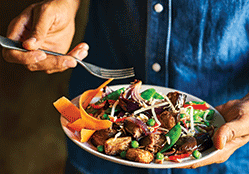Feed your skin

Dr Rupy Aujla advises on some of the best foods to eat for optimal skin health
When you focus on eating for the health of your skin, rather than trying to prevent or rid yourself of a particular condition, you’re actually working to create the perfect environment for your skin cells to thrive. Feed your body the right collection of nutrients and you will be surprised at its ability to look after itself.
Red and yellow vegetables
As well as preventing inflammation and cancer caused by sun damage, the carotenoids found in red, orange and yellow-coloured vegetables like beets, carrots and squash may improve the appearance of skin due to their ability to prevent extracellular matrix breakdown. This is responsible for keeping the structure of the skin firm. Tomatoes, red fruits and papaya also contain lycopene, considered to be one of the most effective antioxidants that prevent damage to cells. Mangoes, papayas and root vegetables all contain a special type of carotenoid called beta-carotene which inhibits free radicals and could give rise to their sun-protective effects.
Greens
Dark, leafy greens such as kale, cavolo nero, cabbage and spring greens are the richest source of the plant chemical lutein, but it can also be found in foods such as broccoli and peas. This phytochemical from the carotenoid family has again been shown to prevent the breakdown of the skin’s matrix, which is essentially the scaffolding that maintains the skin. Dark greens are also a great source of vitamin C which also again inhibits a particular enzyme that breaks down the skin’s structure and therefore could decrease the appearance of wrinkles.
Whole grains, beans and nuts
Whole grains, beans and nuts are a source of copper which encourages skin rejuvenation and wound repair through its collagen crosslinking properties. Almonds, Brazil nuts and sunflower seeds all contain a wide variety of micronutrients, including good amounts of vitamin E that scavenge pro-oxidants in your skin layers. Nuts and seeds are also a source of selenium, which works by increasing the production of enzymes that remove damaging oxides formed during oxidative stress and these can stabilise cells and prevent DNA damage that could prevent mutations leading to cancer.
Polyunsaturated fats from nuts, good-quality oils and fatty fish serve as an important structural component within the epidermis as well as having an anti-inflammatory role.
Plant fibre
As with most medical specialities, there is definitely a connection between your skin and the health of the microbiota (the population of microbes, largely bacteria, found concentrated in your large intestine). A specific gut-skin connection may exist with dermatitis and other inflammatory skin conditions that have an immune component. A lifestyle that nurtures the gut microbiota is essentially one focused on a variety of plant fibres like leeks and chicory and artichokes plus lots of colour in the diet.
Water
As well as the benefits of adequate hydration to brain health, digestion and transport of nutrients through the bloodstream, water maintains the structure of your skin cell walls. Focus on drinking around 1 to 2 litres of plain water per day rather than black teas or coffee, as these can have dehydrating effects.
5-spice sticky aubergine bake

This quick dish is ‘health’ food at its most flavourful. It contains seven sources of plant nutrients, the vegetables provide a healthy dose of fibre and antioxidants, and each of the spices are anti-inflammatory.
Serve this bake as it is or with steaming bowls of brown rice.
Serves:
2 (with leftovers)
Ingredients
- 300g aubergine, cut into 3cm chunks
- 1 red onion, thinly sliced
- 150g peas (fresh or thawed)
- 100g mangetout, roughly sliced
- 1 red pepper, halved, deseeded and thinly sliced
- 100g beansprouts
- 1 small carrot, peeled into long strips with a vegetable peeler
- 25g unsalted cashews, roughly chopped
For the marinade:
- 2 tsp Chinese 5-spice
- 20g root ginger, peeled
- 2 tbsp coconut oil
- 1 tbsp soy sauce
- 1 tbsp maple syrup
- Juice of 1 lime
Method
1. Preheat the oven to 200°C/180°C fan/gas 6.
2. Put the marinade ingredients in a small blender or food processor and blitz until smooth.
3. Put the aubergine and red onion in a baking tray, add the marinade and rub it all over the vegetables. Bake in the oven for 25–30 minutes until golden and crispy.
4. Put the peas and mangetout in a saucepan over a medium heat. Pour in a splash of water (about 30ml), cover and cook for 2–3 minutes, adding more water if needed.
5. Stir in the red pepper and beansprouts, cover again and cook for a further 3 minutes.
6. Once the aubergine and onions are golden and tender remove the tray from the oven. Tip the greens and beansprouts into the oven tray and mix them with the aubergine and onion, adding 2 tablespoons of hot water to the mixture.
7. Divide between two bowls and garnish with the carrot strips and cashew
Extracted from The Doctor’s Kitchen: Eat to Beat Illness by Dr Rupy Aujla
Read previous Your Look articles here...
Read articles from our latest issue here...